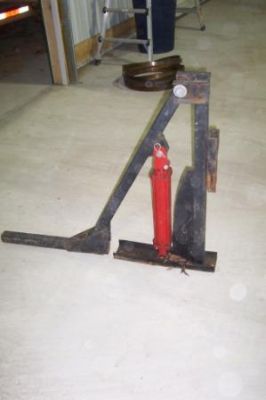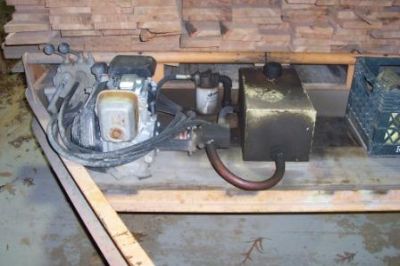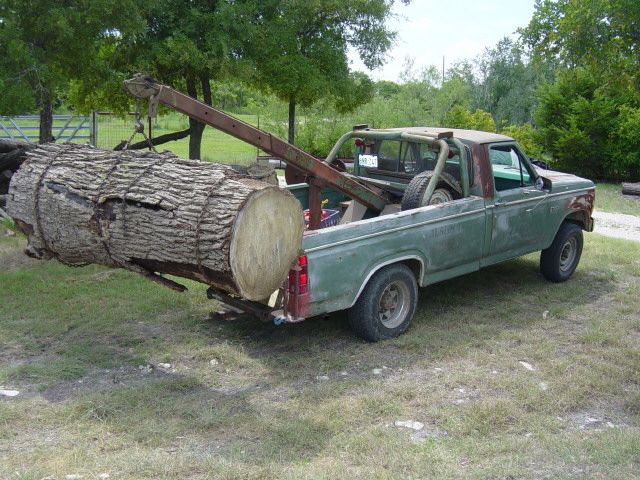Low-Budget Log Handling
Sawmillers discuss winches, trailers, and other sophisticated and economically optimal implements of log manipulation. April 10, 2007
Question
I have a $5000 budget. I need to move logs up to 7000lbs. I still don't have a clear understanding of the best setup. I'm thinking a dual axel (5000lb ea) tilt trailer with a 10,000 lb winch. Should this system work? With this budget, what would work better? Would it be easier to roll a 7000 lb log up the side of a trailer than slide up the back of a tilt trailer? Wouldn't a tilt trailer work better for moving logs than a dovetail? Metal trailer bed better than wood?
Forum Responses
(Sawing and Drying Forum)
From contributor F:
Sure rolling a log will be easier than dragging it, either rolling it from the side or having rollers from the rear. You must have some big trees, dealing with 7000 lb logs! I have my trailer set up to roll them in from the side. I use two ramps, a big manual winch mounted on a bracket made on the tongue (my winch is set up on a pivot pin to swing the front towards either side so I can load from either side). I use a snatch block hooked to the middle of the trailer on the other side from where I am loading. My cable leaves the winch, goes through the snatch block, makes a 90 degree turn and goes over the log, under the log, then comes back to the trailer, over the side, then hooks. I can take one hand and load some big logs (at 7000lb, you are only going to load one per trip, and yeah, I would get an electric winch). I have a short set of ramps to go inside the trailer so the log doesn't roll over the side and just fall into the trailer. Once I get a couple logs loaded, then I remove the inside ramp and roll the logs to the side I am loading on and let the next log roll into the trailer, on top of the other logs. Then I roll the logs if needed to get the last loaded log to settle to the trailer. Once I get the bottom filled, I use the small ramps on top of the bottom logs to roll the next log into the trailer and across to the other side. I have loaded and moved way over 100 logs since I set the trailer up.
From contributor A:
I use the same setup with a 10,000 pound electric winch. It works very well for loading very large logs. Just make sure you use long enough ramps to keep the angle less. And make sure your trailer has the wheels under the deck.
From contributor R:
I have a 16' #12000 capacity flatbed trailer for hauling lumber, slabs, logs, and whatever. For about $2500, I put lifting arms similar to most portable sawmills on the side of the trailer for lifting logs. I have a small gas engine and hydraulic setup on the tongue of the trailer, and two arms that drop in stake pockets on the side of the trailer. You drive next to the logs, roll them on the forks, and use the hydraulics to flip them on the trailer. It works great. I can drive up next to a log, drop the arms in place, and have the log on the trailer in probably 3 or 4 minutes. I'm not sure about the weight capacity of this machine, but I'm sure it will lift over 5000 lbs. The biggest log I've lifted was an oak, 36" x 12'. They are somewhat modeled after the arms on a Timberking.
My design and pivot point puts almost all of the weight of the log on the ground, and not on the trailer, so they would be easily removable. If you want to dedicate the trailer to log handling, you could use the side of the trailer as part of your lifting arms, and therefore cut back on a little fabrication.
From the original questioner:
I'm learning. Just want to make sure I understand. It should be easier/better to roll the log up the side than slide up the back - even though I'll be adding another foot of height (to get over the wheels)?
For a 3' high trailer bed, rolling from the side, how long should the ramps be?
Contributor R, your setup sounds ideal. Just not sure if I understand it well enough or where to get it made.
After giving up the arch trailer idea, I was leaning toward a hd pivoting car hauler. Now, looks like trailer with bed over the wheels is probably the way to go. Thanks for the input.
From contributor R:
I have a Hudson trailer... Deck is about 4 inches lower than the wheels. I wish the deck was higher, but you then need additional lift height. You can get away with a deck lower than the wheels, but you definitely do not want fenders on the trailer if that's the case. My lifting device actually lifts up about 12 or 14 inches higher than the deck of the trailer, so I can get more than one tier of logs on the trailer (if they are small enough). A 3' high trailer deck is pretty high, though. I'm not sure how well my setup would do for that. I would think you would need 8-10' of ramp to load that from the side. My trailer deck is maybe 24" tall at best. I'll get a couple pictures tonight showing one of the arms, and the mount to the trailer. Any welding shop should be able to easily make the arms for you. The hydraulics are pretty simple too and are all off-the-shelf standard items. There is actually nothing wrong at all with ramps and a winch… It just takes a little longer to load that way. That's what I did before making these arms, and time was my only complaint.
From contributor O:
Does your budget include equipment to unload the logs or do you already have equipment at the mill site for that?
From the original questioner:
I have no equipment to help on either end. Was assuming the winch or hydraulic system that got 'em up would get 'em down... Can you tell I need help here?
From contributor D:
I've moved some pretty hefty logs on a 16' flatbed gooseneck, using the side ramp technique and a winch. Since the trailer bed is about 6" lower than the wheels, I put down a couple of 6 x 6 timbers crossways, so the logs clear the wheels. It also makes it easy to roll the logs off with a cant hook, since the log is held up higher than the wheels. It also gives me the option of nailing wood chalks in place to help hold the logs. If you're thinking about a tilt trailer, how about one that tilts to the side instead of to the back? It'd make unloading a lot easier. Of course if you've got the hydraulics to tilt the trailer, a hydraulic winch or loading arms would be an easy way to go.
From contributor R:
Here is the general idea. The arm won't help getting the log off of the trailer. Do what contributor D said - lay timbers on trailer and roll the log over the tires.

Here is the pump and motor on the front of the trailer. I have some lumber loaded up, so I couldn't put the arm on the trailer.

From the original questioner:
Thanks. I understand the basics now. Unless I find someone that I'm comfortable with building this (and can afford), I'll probably start with the simpler winch system. Looks like side roll is the way to go. I've dropped the tilt idea now.
Now, for these large, say 7000 lb logs, I'm wondering if I might benefit from two 10,000 lb winches. (They're $550ish at Harbor Freight.) Or is one 10,000 lb winch strong enough to roll 7000lbs? Also wondering if it might be better to mount them on the bed so they pull straight (possibly mounted to each side of the wheels).
And as for the trailer, what specifics are required for hauling 7000 lbs? Are two 5000 lb axels strong enough? What specifics in construction do I need to look for? Size/thickness of metal, etc?
From contributor R:
I would think that one #10000 would easily handle that load. Remember that your are rolling, not lifting. And you can always lengthen your ramp to lighten the work on the winch. 2 #5000 axles should be fine. Definitely get brakes on both axles, and try to get a trailer with the deck and wheels close to the same height, if not a deck over, no fenders.
From contributor D:
I've always used a single winch line around the middle of the log. If you want to pull the logs off the back of the trailer, use round wood instead of 6 x 6 cants for them to rest on. These act like rollers and make them much easier to pull off. Just make sure they're secure so the log doesn't roll off the back (or try to join you in the cab of the truck) when you're transporting it. Good point about trailer brakes. I wouldn't try it without them.
From contributor A:
I use a Harbor Freight 10,000 lb. winch. Got it on sale for 400 dollars. As for the ramp length, mine are four feet and I wish they were six feet. My trailer has tandem 6,000 lb. axles with brakes on one axle. Make sure the winch has the roller farelead.
From the original questioner:
This afternoon, I came across a deal ($600) on a truck, and am the new owner of a '79 f350. Will be getting new tires among a few other things. Now I'm wondering if I should consider using the bed of the truck (instead of trailer) to get the logs up onto? The bed is taller than the trailer. I think the weight capacity for this f350 is 8900 lbs. Oh yeah, found a friend that is studying the hydraulic idea and might be able to help with it.
From the original questioner:
Specs on the truck:
Gross Weight 9000 lbs.
Maximum Payload 4030 lbs
Max Towing capacity 12,500.
Looks like I will need a trailer after all. This truck should handle the towing a bit better than my SUV.
From contributor B:
Here is my system. An '82 F350 with an 8000# winch. Paid $200 for the rig and about $500 to get it running. I have picked up a 5000# +log - it steered real easy. The winch is mounted on a 3/8" plate about 4'x5' which is bolted through the bed to the frame. I can use it to assist in the direction of the fall, load on trailer, and offload from trailer to mill. I also wrap a chain completely around a big log and lift up to turn big logs on my mill. I am very pleased; it's very versatile. The log in the picture is a 36" bur oak 8'3" long

Click here for higher quality, full size image
From contributor E:
I like the lift on your truck. What size steel is the boom?
From contributor B:
6"x6" and it is about 1/4" thick - bottom section; top section is same thickness and just slides inside.
From contributor L:
Contributor B, your rig is a reinvention of the jammers used in the 40s and 50s. The booms were squared timbers, about 10 inch square. Dad like to use piss elm or white oak timbers. Going around the end of the boom would be a length of log chain with a good sized block hanging from it. Towards the end of the boom on the top would be several spaced notches where you could move the block out or in. Jammers were mostly built on one or ton and a half trucks.
From contributor P:
How about calling a local logger type with a wheeler and cherry picker? For a few hundred bucks you can have hauled 35,000 lbs. No backache or breakdowns.


